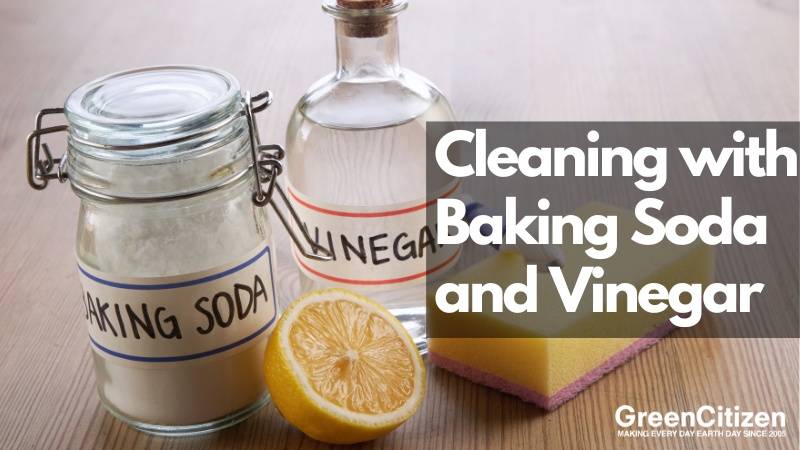Ever read the labels on store-bought cleaning products?
It’s like a chemistry class, with all those long, unpronounceable names. And guess what? Those chemicals aren’t great for the planet or your health.
But here’s a little secret: you don’t need them. For almost any cleaning task, there’s a powerful, budget-friendly solution hiding in your pantry—baking soda and vinegar!
They’re natural, eco-friendly, and safe for you and your family. I’ve ditched the harsh stuff and now rely on this dynamic duo. From scrubbing sinks to freshening up the fridge, these two have transformed my cleaning routine.
Plus, you get that satisfying fizz when they mix—cleaning has never been this fun! Ready to give it a try? Let’s dive into how you can make your home sparkle without the chemical overload.
Understanding Baking Soda and Vinegar Reaction
Vinegar and baking soda was the go-to cleaning product for generations, and if you ask your grandparents, they’ll probably remember a time when there were no other cleaning options.
You made your own as needed, and everything was still perfectly clean.
Let’s see what this simple green cleaning product is all about.
The Science: Neutralization Reaction
Sodium bicarbonate, or baking soda, is a slightly alkaline powder. That high pH can pack a good cleaning punch when it comes to tough dirt and grease by gradually loosening the grime.
White vinegar, on the other hand, has a very acidic pH that can also rip through grease, limescale, and dried stains. And when you combine the two, they can create a chemical reaction that tackles dirt from multiple angles.
During this reaction, the acid breaks down the baking soda while releasing carbon dioxide gas. At the same time, this reaction can break up dirt and grease from all types of surfaces.
The chemical reaction between baking soda (sodium bicarbonate) and vinegar (acetic acid) is called an acid-base reaction. This reaction produces carbon dioxide gas, water, and sodium acetate. The overall reaction is:
Baking soda (sodium bicarbonate) + Vinegar (acetic acid) → Carbon dioxide gas + Water + Sodium acetate
This reaction is often referred to as a neutralization reaction because an acid (vinegar) reacts with a base (baking soda) to form a salt (sodium acetate), water, and carbon dioxide gas.

The Ingredients
So, the first thing I would say is that you want to use high-quality distilled white vinegar. You’ll pick this up in any supermarket, and I suggest that you buy a large bottle so that you can mix up different solutions for different cleaning jobs.
More on that shortly.
Then, when it comes to baking soda, most supermarkets will sell relatively small tubs of it, as you don’t need much of it for baking.
When it comes to cleaning, you’ll want to have a larger supply, so shop around to see if you can get a large tub normally bought for commercial use.
The Right Mix
The important thing to keep in mind is that depending on what you’re cleaning, you’ll need a different kind of mix. In some cases, you want to sprinkle baking soda and vinegar directly onto a surface and let the reaction kick off before you start rubbing it in with a cloth.
In other situations, you’ll need to mix half a cup of baking soda with two cups of white vinegar and mix it in a spray bottle.
Don’t worry; I’ll give you the ideal mixes for different jobs shortly.
One mistake many people make is mixing equal parts baking soda and white vinegar for every single job. But that can be wasteful and, in some cases, even do more damage than good.
11 Things You Can Clean With Baking Soda and Vinegar
Let me introduce you to the best uses I have found for vinegar and baking soda outside of preparing food.
1. Smelly And Clogged Drains
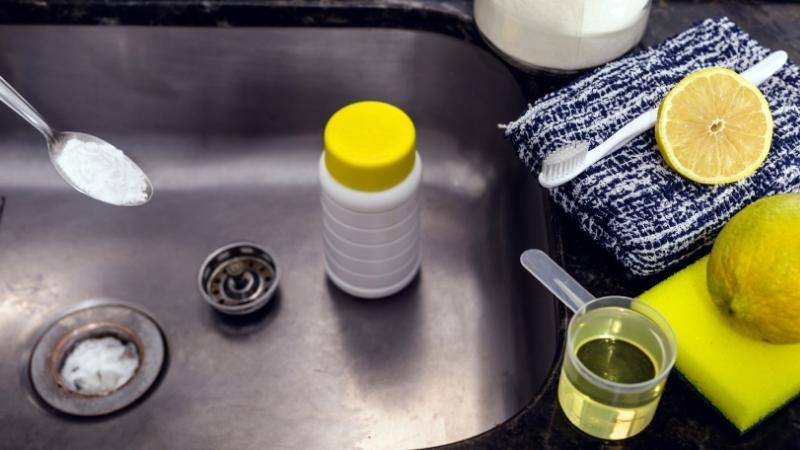
Rather than use a chemical drain unblocker, get your baking soda and vinegar ready and watch the magic happen.
Even if the drain isn’t completely blocked, you might find that grease and dirt from washing dishes accumulate in the drain. And between bacteria and mildew, you’ll notice some bad smells rising.
A simple solution is sprinkling baking soda down the drain first; about half a cup should be enough. Then, slowly pour a cup of vinegar down the drain as well. You should see the mixture bubbling up, and that reaction is releasing the cleaning power to break up grime.
Leave it to soak for about 20 minutes, and then pour hot water down the drain for a couple of minutes.
You should notice that your sink empties a lot faster and that the smells are gone.
I tend to do this every few weeks to avoid the smells and potentially allowing a health hazard to develop.
2. Washing Machines
You’ll probably occasionally notice a bad smell coming from your washing machine. And if you don’t deal with it, then that smell can transfer to your clothes.
What I do is fill a small plastic cup with 1.5 ounces of vinegar and two tablespoons of baking soda. I also sprinkle baking soda into the detergent compartments for pre-wash, main wash cycle, and rinse cycle.
What you’re doing here is adding baking soda and vinegar to all areas where water flows and mildew can grow.
I generally do this once a month and in an empty cycle at quite a hot temperature. If the smell has become particularly bad, then I would increase the amount of baking soda and vinegar and maybe run this cleaning cycle a second time.
This can happen if you’ve been away on vacation for a couple of weeks.
3. Kitchen Sink And Surfaces
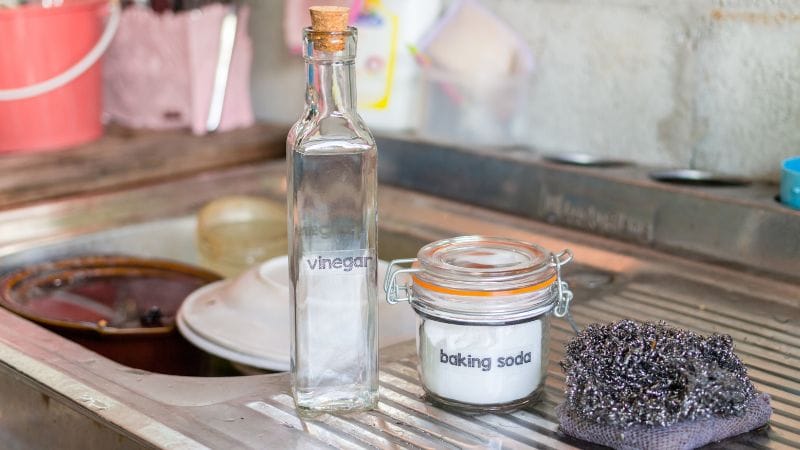
Another great use for baking soda and vinegar is to create a general-purpose cleaner that you can use for kitchen surfaces, including your sink.
Dirt, bacteria, and even just dish soap scum can build up all over the place, and you don’t have to use harsh chemicals that can destroy the environment and even be harmful to your health.
Here’s what I mix up. It’s a recipe I got from my grandmother, so it’s stood the test of time.
- 1 cup of baking soda
- 1 cup of water
- 1/3 cup of vinegar
Mix it up in a spray bottle and then give it a good shake and watch the baking soda and vinegar react.
You can use this mix on most surfaces, but I wouldn’t recommend it for natural stone countertops.
Also, don’t mix up large batches. It’s better to combine vinegar and baking soda fresh every few days to get the full benefit during your cleaning process.
4. Garbage Disposal
People have a tendency to either not clean their garbage disposal enough, or they use way too many chemical cleaners. Similar to your drain cleaning process, you can add a mix of baking soda and vinegar here as well.
I would suggest that you add baking soda first and even turn on the garbage disposal for a few seconds to properly spread it out.
After applying baking soda, add a cup of white vinegar. Wait about 10 minutes for the bubbling effect to stop. This is where the vinegar breaks up the grime to make it easier to remove.
Turn on the garbage disposal and keep running hot water through it to completely loosen and flush away the dirt.
Depending on how often you use it, you should probably do this about once a week to avoid bacteria, smells, and mold.
5. Oven
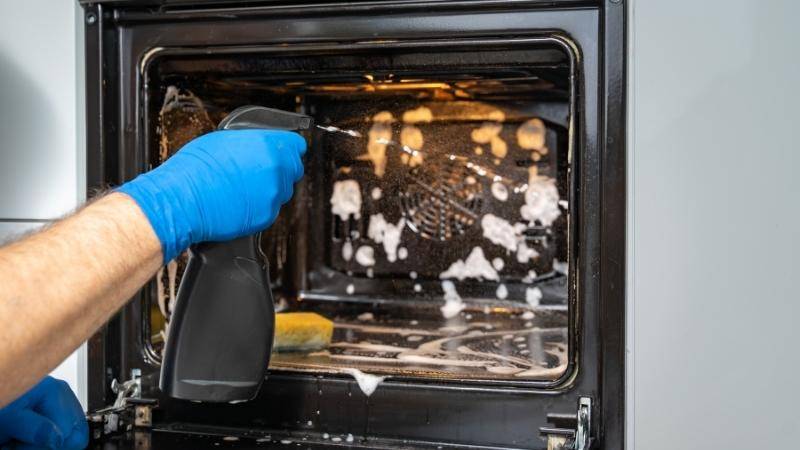
This is one place where you really should avoid using harsh chemicals. No matter how well you wipe away a cleaning solution, there will still be some residue. And that can then evaporate into the air you breathe or even get absorbed into your food.
You can use a similar mix to the general surface cleaning one I listed in point 3 above, and I would suggest mixing a fresh batch in a spray bottle before tackling your oven.
Start by spraying all the surfaces and letting the vinegar and baking soda mix soak into stubborn stains and carbonized food.
If you see some particularly tough grime and burnt food, then sprinkle baking soda onto the area and spray some extra vinegar into the mix.
You can also crumple up some aluminum foil into a small ball and use that as a tool for scraping and scrubbing tough dirt.
6. Dryer
Now, some people recommend soaking a towel in warm water and white vinegar solution, but I’ve found that you end up with a vinegar smell in the dryer that can transfer to your clothes.
Here’s what I have done instead.
I get a medium-size towel and soak it in warm water and sprinkle baking soda in as well. About half a cup should be enough, and just let it soak for a few minutes.
Wring out the towel and place it in the dryer for a full drying cycle.
The baking soda won’t leave a smell, and it should help to remove mildew, mold, and bad smells.
One thing that I have found to be a major contributing factor to a smelly dryer is if you use a lot of fabric softener. Try using less or skip it altogether, and you’ll quickly notice a difference in your dryer.
7. Limescale And Soap Removal

Here’s another great use for baking soda and vinegar, especially for the faucets around your home. If you have particularly hard water, then you’ll notice a limescale build-up. And it’s also more likely that soap scum deposits build up because soap doesn’t fully dissolve in hard water.
Here’s the way I’ve been able to deal with hard water stains best.
I spray vinegar directly onto the faucets and then mix up a baking soda paste. You can use a teaspoon of baking soda mixed with cold water and then rub the paste into the vinegar on the faucets.
Use a damp cloth to gently rub it in, and you’ll notice that it will lift dirt and limescale. Then simply wipe clean with a wet rag, and it should be as good as new.
One thing you need to keep in mind is that you don’t want to use this on brass faucets, as baking soda and vinegar can damage the brass.
8. Pots And Pans
Here is a tip that will reduce how much elbow grease you need to apply after cooking food. You can use baking soda and vinegar to lift burnt grease and food off pots and pans within minutes.
First, fill your pots and pans with boiling water and add some vinegar to them. Let the water cool down and while you’re waiting, mix up a baking soda paste with a drop of water and a tablespoon of baking soda.
You’ll find that it should have a slightly sandy feeling texture, and this will give it a gentle abrasive effect when you clean your pots.
Now, drain some of the hot water and use a dish sponge to apply some of the baking soda paste. Gently rub it into the surface and watch all the stubborn stains come loose.
You should then be able to rinse it off with cold water.
9. Mildew And Mold
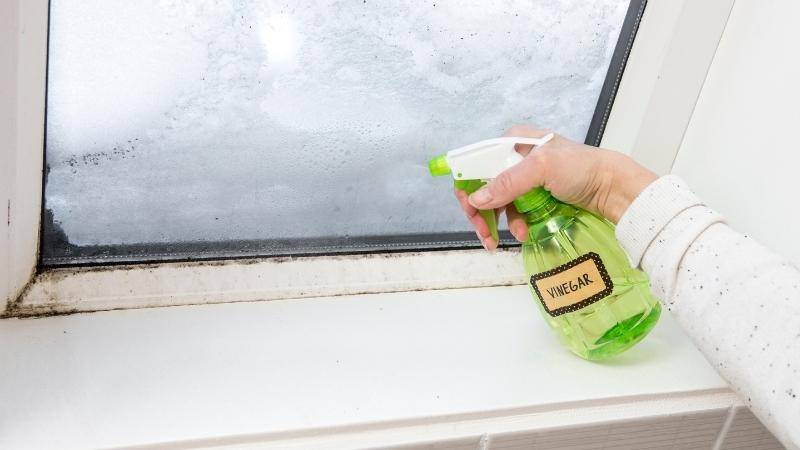
This is something you might find around your shower and bath, and it’s important to always deal with mold quickly. Check all the grout lines around your bathroom for signs of any dark stuff that you can’t simply wipe away.
What manufacturers of cleaning products don’t tell you is that baking soda and vinegar are far more powerful at breaking down mold than any chemical.
Of course, they wouldn’t be able to charge you $8 for a bottle.
Mix up a fresh batch of baking soda and vinegar in about 1 part baking soda to 2 parts vinegar. Shake the bottle well and wait for the carbon dioxide bubbling action to stop.
Spray it directly onto the mold and wait for about 10 minutes. Then use a clean cloth to wipe away the mold. You might need to repeat this a few times, but it’s a more effective solution than any store-bought product.
10. Showerheads
The next time you notice that your showerhead is blocked with limescale, don’t reach for a chemical descaler. Baking soda and vinegar will work perfectly fine.
Remove the showerhead from the hose and stand it in a bowl. Then, sprinkle baking soda into the opening where you attach the shower hose.
I carefully add about a tablespoon or more depending on how much limescale build-upbuild-up there is.
Then, slowly pour two cups of vinegar into the showerhead and watch as it starts to bubble up as all the magic happens.
This simple mixture will dissolve any limescale build-up, and it should just come loose.
All you need to do is rinse it out with some warm water.
11. Glass

And finally, you can also use baking soda and vinegar to get any glass surface or drinking glasses sparkling like they never have before. Get a small bowl of warm water, and add a teaspoon of baking soda and a tablespoon of vinegar. You can then dip glasses in the water and use paper towels to polish them clean.
If you’re cleaning windows or other glass surfaces like a tabletop, then use a soft cloth to polish it with this solution.
You should find that it leaves a streak-free appearance.
A tip I got from my grandmother for cleaning glasses is to add a small drop of lemon juice. This will counteract the smell of acidic vinegar, which isn’t too nice in drinking glasses.
One thing I would say is that you should avoid using baking soda paste on glass, as it can end up permanently leaving scratches on the surface.
Why Baking Soda and Vinegar Are Better Than Store-Bought Cleaners
When it comes to cleaning, baking soda and vinegar are like the ultimate tag team—powerful, natural, and eco-friendly.
Unlike store-bought cleaners filled with harsh chemicals and artificial fragrances, baking soda (sodium bicarbonate) and vinegar (acetic acid) offer a safe alternative for your home and the environment. These pantry staples can tackle grime, remove stains, and deodorize surfaces without leaving harmful residues or contributing to indoor air pollution.
Store-bought cleaners often contain toxic chemicals like ammonia and bleach, which can be harmful to your skin, eyes, and respiratory system. In contrast, baking soda is a gentle abrasive, perfect for scrubbing without scratching, while vinegar’s acidic nature cuts through grease and disinfects naturally.
Plus, mixing baking soda and vinegar creates a fizzy reaction that can unclog drains and lift stubborn dirt, making it a versatile cleaning solution.
By choosing baking soda and vinegar, you’re opting for a non-toxic, budget-friendly approach to cleaning that’s just as effective—if not more so—than its commercial counterparts. So, ditch the chemical cleaners and embrace the natural power of baking soda and vinegar for a healthier, cleaner home!
Final Thoughts
Vinegar and baking soda are the best green cleaning solutions you could possibly start using in your home. And with so many different ways to use it, you could eliminate 95% of your chemical-based products instantly.
Not only is it better for the environment, but it can be much healthier for your family.
And don’t forget that if you bulk-buy vinegar and baking soda, you can save a lot of money by avoiding all those expensive cleaning products.
Start trying it out with simple things like cleaning pots and pans and keeping your drains clear. You’ll quickly see how well this works, and I bet you won’t be looking for all those old bottles under the sink.
